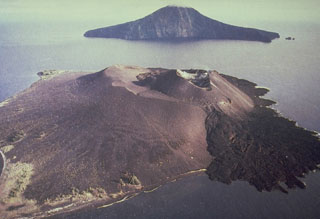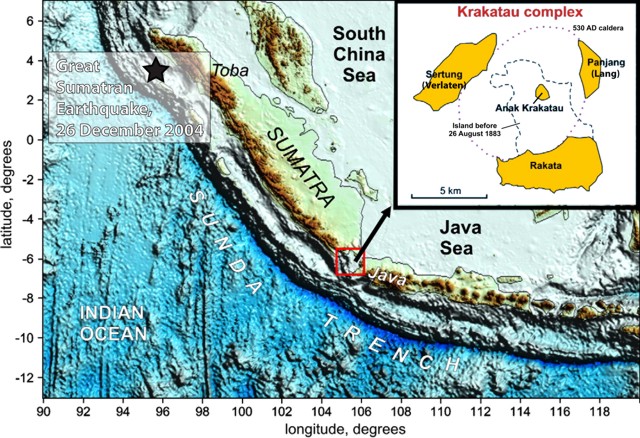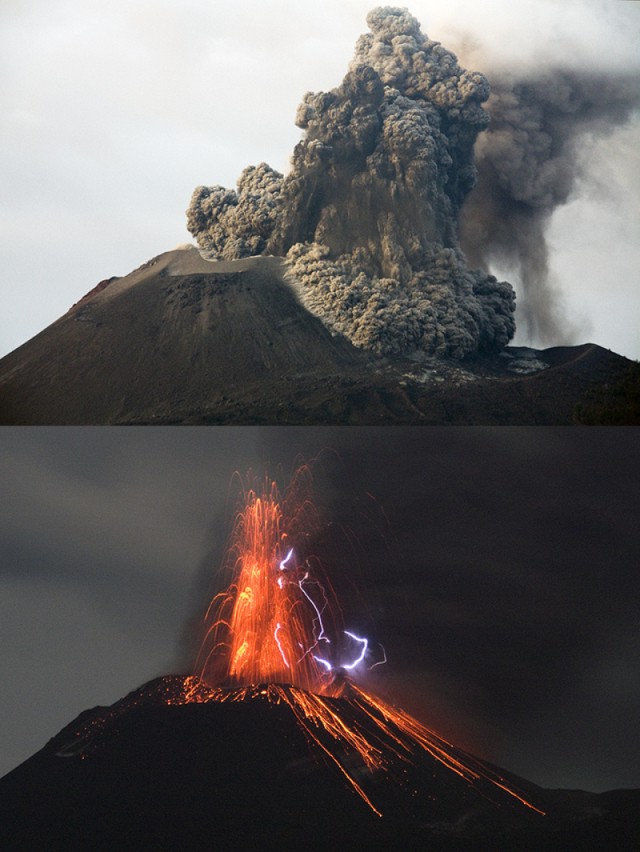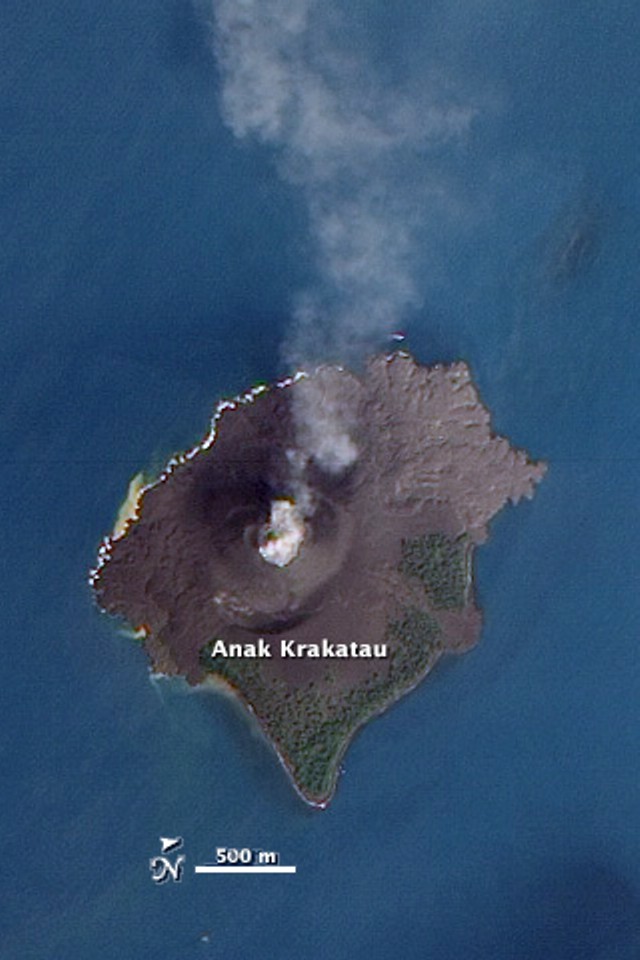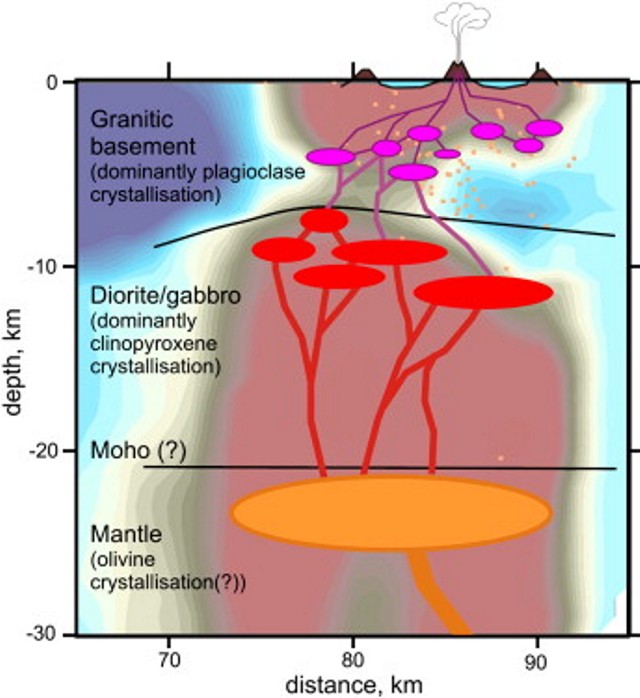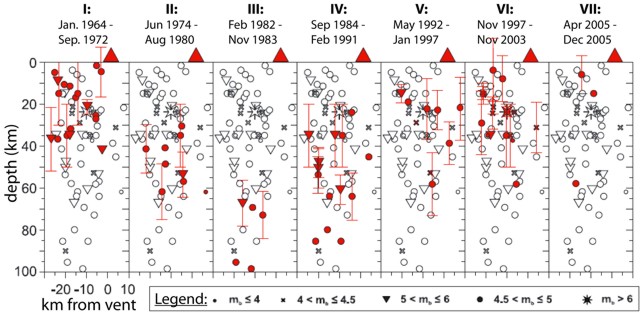Report on Krakatau (Indonesia) — August 2011
Bulletin of the Global Volcanism Network, vol. 36, no. 8 (August 2011)
Managing Editor: Richard Wunderman.
Edited by Robert Dennen.
Krakatau (Indonesia) 2009-2011 eruptive phases; magma plumbing; date of ancestral eruption
Please cite this report as:
Global Volcanism Program, 2011. Report on Krakatau (Indonesia) (Dennen, R., and Wunderman, R., eds.). Bulletin of the Global Volcanism Network, 36:8. Smithsonian Institution. https://doi.org/10.5479/si.GVP.BGVN201108-262000
Krakatau
Indonesia
6.1009°S, 105.4233°E; summit elev. 285 m
All times are local (unless otherwise noted)
Anak Krakatau (the active post-collapse cone of Krakatau volcano, figure 23) began another eruptive [period] around 25 October 2010, characterized by up to hundreds of explosions per day (e.g., 251 explosions during 31 October-1 November 2010 as noted in the Jakarta Post). In November 2010, Arnold Binas documented explosive activity, ballistic bombs, column collapse generating pyroclastic flows, and volcanic lightning... (figure 24).
According to the Center for Volcanology and Geological Hazard Mitigation (CVGHM) and the Darwin Volcanic Ash Advisory Centre (VAAC), ash plumes reached heights of 2.4 km altitude on 24 December 2010 and 12 January 2011; on 15 January 2011, an ash plume reached 3 km altitude. Ashfall in early January 2011 covered the solar panels running seismometers monitoring Anak Krakatau, rendering them inoperative until rainfall cleared the ash from the solar panels. Following the seismometer failure and amid continued activity of the volcano, the South Lampung Disaster Mitigation Agency (BPBD) ordered the evacuation of seven districts (of the 17 districts of South Lampung Regency) on 11 January 2011 (Jakarta Post).
In March 2011, the activity at Anak Krakatau decreased and the eruption was considered to be over. According to a local news service (TO:DAY), the head of the Anak Krakatau monitoring post reported that in the previous month, volcanic earthquakes became fewer and at greater focal depths. They had ranged from a high of 500-600 shallow earthquakes per day, declining to dozens per day in March 2011. The eruptive pause lasted, at most, until 31 July 2011 when NASA's Earth Observing-1 (EO-1) satellite observed a diffuse plume drifting W (figure 25).
In August, Andi Rosadi reported on the Volcano Discovery website that the seismometer monitoring Anak Krakatau was again damaged by explosions venting from the summit crater, noting "many quite big new bombs around the old crater." CVGHM reported that GPS measurement stations had been damaged as well. Rosadi also described and photographed large areas of incandescence within the summit crater on 8 August 2011, reporting a lava dome or "dry lava lake glowing in the central crater" (figure 26). The Volcano Discovery website noted that on 6 September 2011, Chris Weber reported fire fountaining reaching ~10 m high.
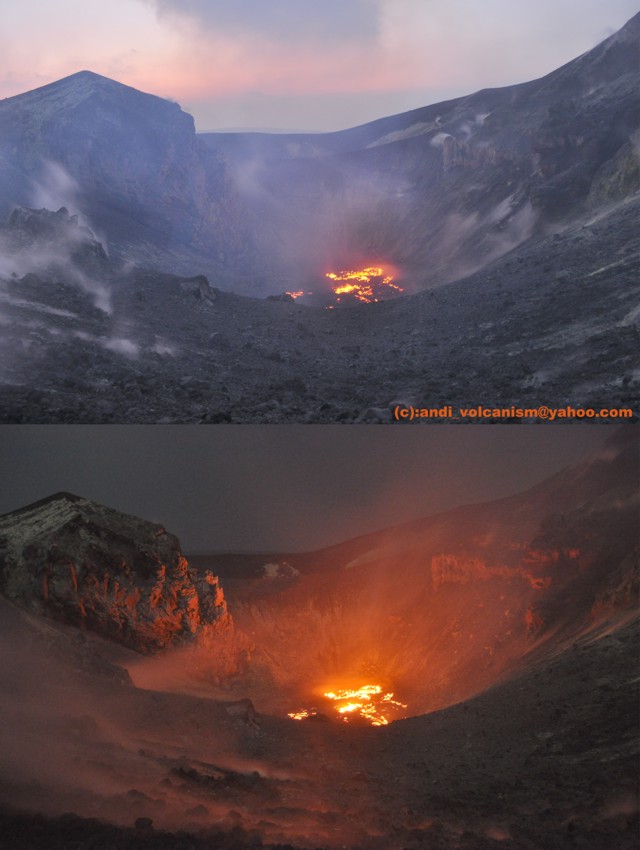 |
Figure 26. Incandescence within the summit crater of Anak Krakatau seen from similar perspectives on 8 August 2011, at 1731 (top), and at 1830 (bottom). Courtesy of Andi Rosadi, Volcano Discovery. |
On 30 September, CVGHM reported that the seismometers were again operational following 18 September, and increased the Alert Level from 2 to 3 (on a scale from 1 to 4), citing visual and seismic observations. Visually, while no ash producing eruptions had occurred from 14-30 September, CVGHM reported that the E flank of the volcano was covered in solfataras, with thin gusts of smoke within the crater and along crater walls. They also reported vibration in the body of the volcano within distances of 700 m from the summit. Seismically, from 18-30 September, CVGHM reported persistent volcanic earthquakes (volcanic earthquake swarms), noting that volcanic earthquakes had reached a level of 4-5 events per minute. As of 3 October, the Alert Level remained at 3, and residents and tourists were prohibited within 2 km of the crater.
Plumbing of the Krakatau system.Three recent publications addressed magma generation and plumbing of the Krakatau system from different disciplinary approaches. Employing mineral-melt equilibria thermo-barometry on Krakatau's phenocryst phases of clinopyroxene and plagioclase, Dahren and others (2010) demonstrated that clinopyroxene crystallizes at 8-12 km depth, while plagioclase crystallizes at 4-6 km depth. The two crystallization depth ranges could suggest multiple magma storage regions in the Krakatau system. They also noted that clinopyroxenes erupted before 1981 recorded deeper crystallization (and thus storage) - depths of 8-22 km - indicating a shallowing of the plumbing system over the last ~ 40 years.
From seismic tomography and inversion, Jaxybulatov and others (2011) reported a multi-layered structure beneath the Krakatau system (figure 27). They found their model similar to the one noted above (Dahren and others, 2010). They also reported that the deep-focus earthquakes they studied (100-160 km focal depths) were likely related to phase transitions and fluid fluxes in the subducting slab. They suggested these could lead to diapirism and formation of magma chambers in the overlying mantle wedge and crust.
In their spatial and temporal analysis of seismological data from 1964-2005, Špièák and others (2011) reported both deepening and shallowing of earthquake foci over the past 40 ? 5 years (figure 28). This result is not dissimilar to that of Dahren and others (2010), but ?pièák and others (2011) concluded that the pattern reflects "depth variations of tectonic stress concentration rather than vertical migration of the source of magma." Similar to Jaxybulatov and others (2011), ?pièák and others (2011) also reported that the deepest events (~100 km) constrain the primary magma generation of the system to depths greater than 100 km. They further noted an aseismic gap in the Wadati-Benioff zone of the subducting plate at 100-120 km depth. They inferred that this gap is likely the consequence of partial melting "inhibiting stress concentration necessary to generate stronger earthquakes," while an increased occurrence of earthquakes in the lithospheric wedge above probably reflects magma ascent.
Revised first millenium eruption date. Prior to 2000, a caldera-forming event at Krakatau ("Proto-Krakatau") was hypothesized to have occurred circa 416 CE. From an intensive, multi-disciplinary approach, Wohletz (2000) hypothesized that the catastrophic event actually occurred in the year prior to widespread climate perturbation during 535-536 CE. He noted that the 338th century of the Shaka calendar was probably previously mis-aligned to 416 CE of the western calendar. Since Wohletz (2000), the date of this eruption is widely accepted as 535 CE (see inset of figure 23 for map representation of the caldera's topographic margin).
References. Dahren, B., Troll., V.R., Andersson, U., Chadwick, J.P., and Gardner, M.F., 2010, Investigating magma plumbing beneath Anak Krakatau volcano, Indonesia: evidence for multiple magma storage regions, Geophysical Research Abstracts, v. 12, 1607-7962; in7th EGU General Assembly, 2010.
Jaxybulatov, K., Koulakov, I., Ibs-von Seht, M., Klinge, K., Reichert, C., Dahren, B., and Troll, V.R., 2011, Evidence for high fluid/melt content beneath Krakatau volcano (Indonesia) from local earthquake tomography, Journal of Volcanology and Geothermal Research, v. 206, p. 96-105.
Špièák, A., Van?k, J., and Hanu?, V., 2011, Recent plumbing system of the Krakatau volcano revealed by teleseismic earthquake distribution, International Journal of Earth Sciences, v. 100, p. 1375-1381.
Wohletz K.H., 2000, Were the Dark Ages triggered by volcano-related climate changes in the 6th century? EOS Transactions of the American Geophys. Union, v. 48(81), F1305.
Geological Summary. The renowned Krakatau (frequently mis-named as Krakatoa) volcano lies in the Sunda Strait between Java and Sumatra. Collapse of an older edifice, perhaps in 416 or 535 CE, formed a 7-km-wide caldera. Remnants of that volcano are preserved in Verlaten and Lang Islands; subsequently the Rakata, Danan, and Perbuwatan cones were formed, coalescing to create the pre-1883 Krakatau Island. Caldera collapse during the catastrophic 1883 eruption destroyed Danan and Perbuwatan, and left only a remnant of Rakata. This eruption caused more than 36,000 fatalities, most as a result of tsunamis that swept the adjacent coastlines of Sumatra and Java. Pyroclastic surges traveled 40 km across the Sunda Strait and reached the Sumatra coast. After a quiescence of less than a half century, the post-collapse cone of Anak Krakatau (Child of Krakatau) was constructed within the 1883 caldera at a point between the former Danan and Perbuwatan cones. Anak Krakatau has been the site of frequent eruptions since 1927.
Information Contacts: Center for Volcanology and Geological Hazard Mitigation (CVGHM), Jl. Diponegoro 57, Bandung, West Java, Indonesia, 40 122 (URL: http://www.vsi.esdm.go.id/); Arnold Binas, Sydney, Australia (URL: http://www.arnoldbinas.com); Darwin Volcanic Ash Advisory Centre (VAAC) (URL: http://www.bom.gov.au/info/vaac/); The Jakarta Post (URL: http://www.thejakartapost.com/); TO:DAY (URL: http://today.co.id/); NASA Earth Observatory, NASA Goddard Space Flight Center (URL: http://earthobservatory.nasa.gov/); Andi Rosadi, Chris Weber, and Tom Pfeiffer, Volcano Discovery (URL: http://www.volcanodiscovery.com/).

